How to Design Your Dream Kitchen With Luxury Appliances
March 13th, 2024 | 11 min. read
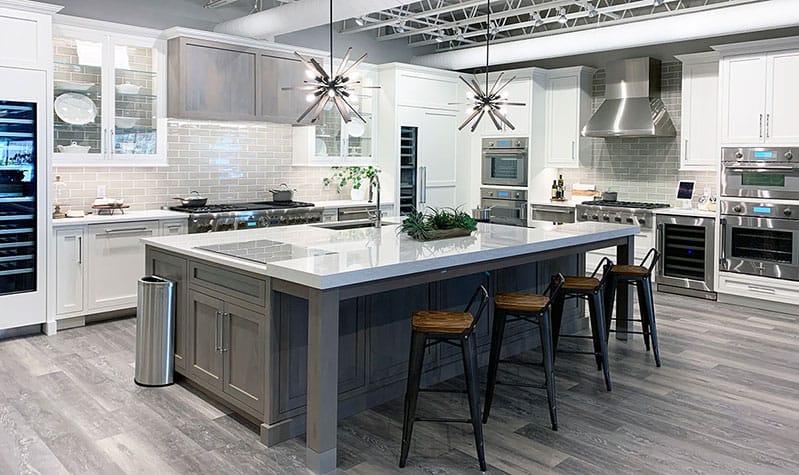
Construction is scary.
Kitchens are the scariest rooms to remodel because they require the most plumbing, lighting, and exact measurements.
To have a functional kitchen, you need a plan of action to place appliances and cabinets in the right areas.
I have remodeled two homes in the last ten years and know the pitfalls.
This article will provide the master plan you need to create your dream (or any) kitchen.
You will learn where to start, what appliances should be chosen first, and all subsequent important decisions.
We will also tell you about the differences between all high-end products.
No brand can satisfy every requirement, so you want to buy whatever brand best matches your cooking style.
As a bonus, you will also see what not to do.
There are plenty of beautiful yet unfunctional kitchens on the internet.
I hope this article inspires you. If you have questions or need help, please leave comments at the end.
[inlineCTA]
Appliance Availability in 2024
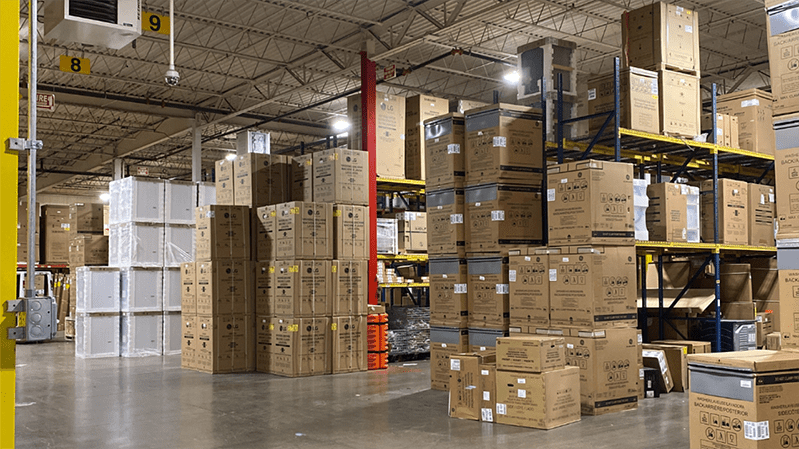
Let's start with some good news.
In 2019, you bought your appliances 2-3 months before they were needed. That was fine. In 2020-2023, you waited twelve to eighteen months.
In 2024, we will be back at 2019 levels, so you don't need to plan 12 months ahead.
So don't be pressured by all those appliance people all over you to place an order.
You have time until you start construction.
Labor Problems
You may have time, but you must make decisions because your plumbers and electricians are in short supply.
So, make timely decisions because you may have to wait a month for the subcontractors to return.
A few missed deadlines will send your project into freefall.
How to Design Your Dream Kitchen with Luxury Appliances
Let's start our journey with a beautiful and functional luxury kitchen.
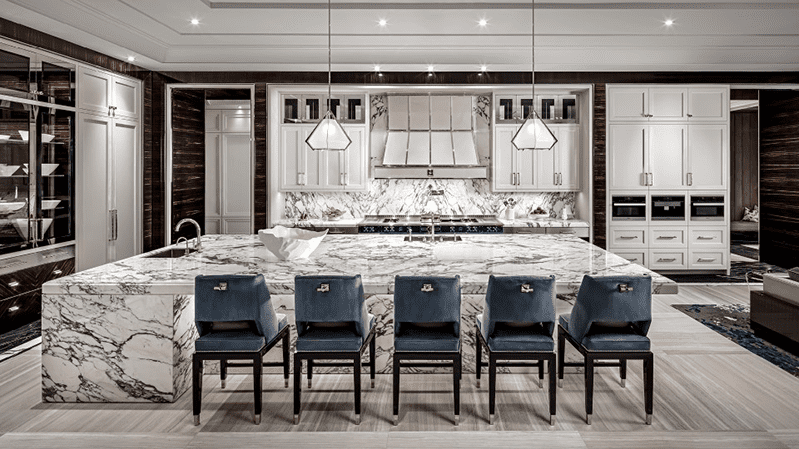 Drake’s (the Rapper) Kitchen
Drake’s (the Rapper) Kitchen
You are looking at about $20,000 worth of appliances.
This kitchen is always the last slide if you have ever seen our webinars.
It's well-designed and attractive.
Let's talk about the luxury appliances in Drake's kitchen:
- The Château Supreme and hood
- Two 24-inch columns
- One 18-inch wine cooler
- A Miele coffee maker
- A speed oven and steam oven
- Two dishwashers
- Two sinks
All are great selections and are considered the best available (depending on how you use them).
Look at the pot filler at the back of the stove.
You can fill pots without lugging around water.
This kitchen is so well-conceived that he doesn't need it.
Now, scroll up to the original picture. What you want to do is look at the placement of the appliances.
Notice where the sink is. It's close to the range.
You should also note where the refrigeration is located. It's located away from the main flow of your appliances.
You will learn why this is important and, by the end, be able to design a kitchen to this degree yourself.
Let's dive in.
The ABC Dream Team (Architects, Builders, Contractors)
Finding the right people before ruminating over tile, floors, lighting, cabinets, and appliances.
I have redesigned a condo, rebuilt a burnt-out Brownstone, and designed Yale Framingham.
My biggest issues were contractor-related, without question.
Great people know the best subcontractors. You will have ideas and other considerations from people who work on similar projects.
Bad contractors cause problems.
Finding a Project Manager
So, you've hired a great contractor.
You are half done.
Now, you want to start the interview process all over for the best Project Manager.
You don't want the owner's kid fresh out of college but someone more seasoned.
This person should have a background in working with the trades, framers, foundation people, cabinet people, electricians, painters, plumbers, and roofers.
They must be organized.
Think of hiring these teams based on the expectation of having an 18–24-month marriage.
Treat it accordingly.
Questions to Ask When Vetting Architects, Builders, and Contractors
If you are building a contemporary house, you ideally want someone who has built a house in that style.
For Bostonians, you have the unique Brownstones.
You want to find the contractor best matching that particular style.
The following are 18 questions to ask your architect, builder, and contractor:
- How long have you been a General Contractor for? (How many years of construction experience do you have)
- Are you licensed by the state in which the project is located?
- Do you have Proper Insurance, current and up to date with at least 1mill GL?
- Are you familiar with the city/town Permit Process and Bylaws?
- Have you built new homes in the past? Locations? ( If a new home is the Scope of work).
- Would I have a point of contact for my project?
- What companies do you typically use for subcontractors?
- Do you have any references I can contact?
- How does your payment schedule work?
- What would be your timeline for the project?
- What type of warranty do you offer?
- Can you provide a letter of completion? (To avoid any type of lien against the property).
- What do you see as the biggest challenges for this project?
- What is your policy on project delays?
- How do you close out a project? (A good contractor would clean the site like he was never there),
- Do I get weekly and or monthly progress reports?
- How can we receive the written proposal?
- Would the proposal have a detailed list of material?
Bonus Tip: You should meet with your project manager weekly. You want to know if there are any problems before the project goes sideways, especially if your contractor is looking for money. I wish I had.
Knowing Your Self and Lifestyle
Before you copy that kitchen on Houzz or off the internet, assess how you use the space.
How do you cook? Do you cook? Do you mind bending down for a stove? Is there an object you will be highlighting?
If you are on the ocean as an example, you would want your kitchen to be positioned to take advantage of the water views.
The following are questions to ask yourself before planning your kitchen layout:
- How much space do you have?
- Do you and/or your partner like to cook?
- What appliances do you use frequently?
- Do you have an object you’re highlighting?
- Will your lifestyle be changing?
- Don't copy somebody else's !!!!
- Do you store wine?
- Do you entertain often?
- Would you use a steam or speed oven?
- Do you need an icemaker and what type of ice?
- How much refrigeration do you need and where would you place it?
- Do you bake or broil more? Grill? Griddle?
Where to Start Your Kitchen Project
Without question, you should start at the sink.
It seems odd for an appliance guy to say, start at the sink. However, your sink is the most used "appliance" in your kitchen. You do use the sink more than a stovetop.
Positioning a sink on an island is ideal.
You won’t have any venting issues and you can personalize your kitchen with lights like in this picture:
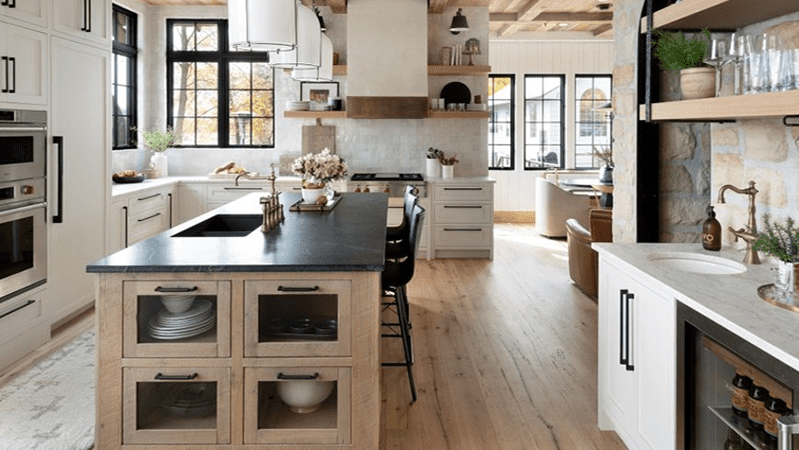
You are looking at the number four most viewed kitchen on Houzz last year.
It garnered thousands of views. The style is excellent. Look at the floors, ceilings, and the black handle accents.
Yet, the sink is wrong, assuming they use the stovetop.
If they do and burn their food or, heaven forbid, start a fire, their sink is not accessible.
You should always place your sink near your cooking appliances.
My Version of the Kitchen Triangle and Why It's So Important
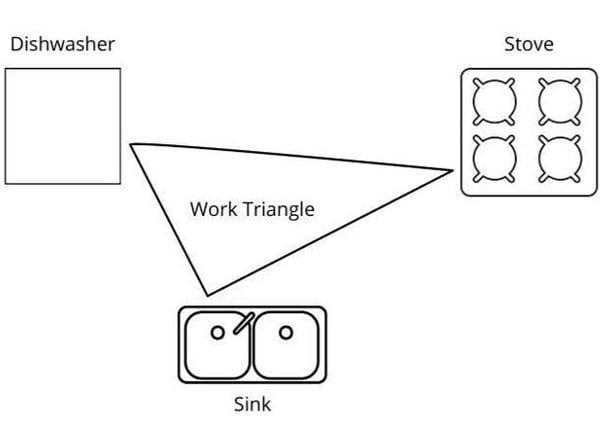
The kitchen triangle keeps the most used appliances nearby.
My version of the kitchen triangle is to centrally locate the the sink, stovetop, and dishwasher (shown above).
Your Other Appliance Decision
The other appliance decision you must make is buying a wall oven and cooktop or a range.
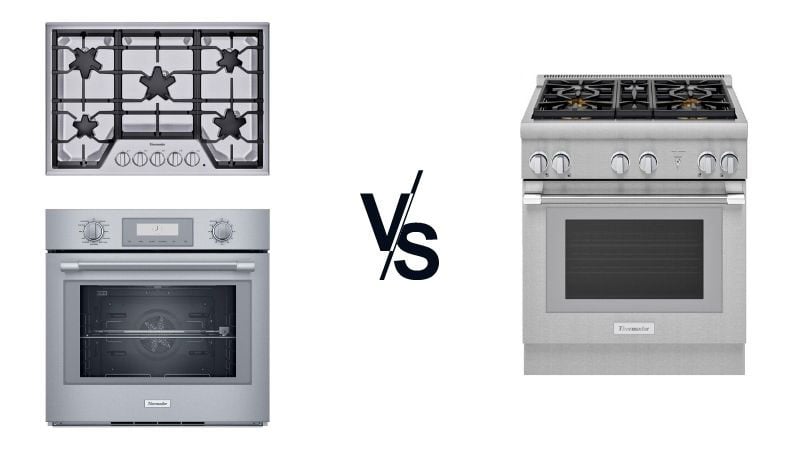
The decision depends on various factors. The range is better if you have a smaller space.
It also centralizes everything.
Then again, you can place a wall oven anywhere.
It may sound like a novel concept, but you don't check the food in your wall oven as much.
Options like steam, speed, microwave ovens, and warming drawers are more readily available in a wall oven to personalize your cooking a bit better as well.
You also do not bend for a wall oven like you do a range.
Hard to believe, but after placing your sink and cooking appliances, your kitchen layout is almost done.
Every other appliance is a standard measurement.
Your only other decision is what type of appliances and secondary appliances you want in this kitchen.
Read More: How to Plan Your Kitchen Appliance Project
What Not to Do in a Kitchen
You don't want to fall into two major traps. The first you have seen. It is the positioning of the sink or stovetop far apart, like in this kitchen:
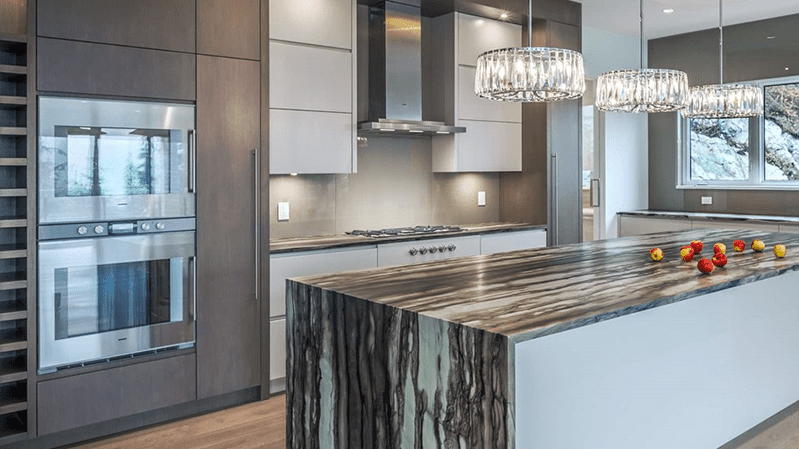
They could move the sink across from the stovetop and place a wet bar on that side. The sink in that position does take advantage of looking outside, but the position does not work.
Stovetop Ventilation Issues
Venting is a big problem, and these problems are tough to fix after the fact.
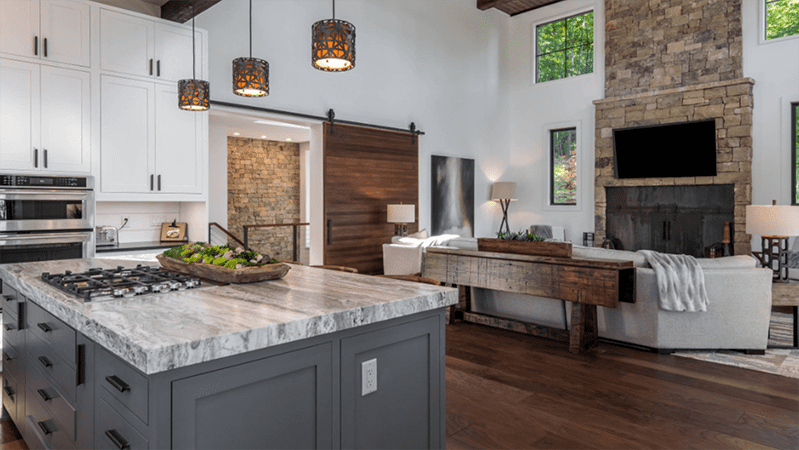
Most vents don't work effectively.
They don't have enough depth or adequate power.
Your range is more powerful than when I started, so the smoke, grease, Nitrous Oxide, Carbon Dioxide, Carbon Monoxide, Formaldehyde, and particulate matter (PMI) is emitted into your kitchen.
Your more energy-efficient windows keep all that in your house longer.
Downdrafts
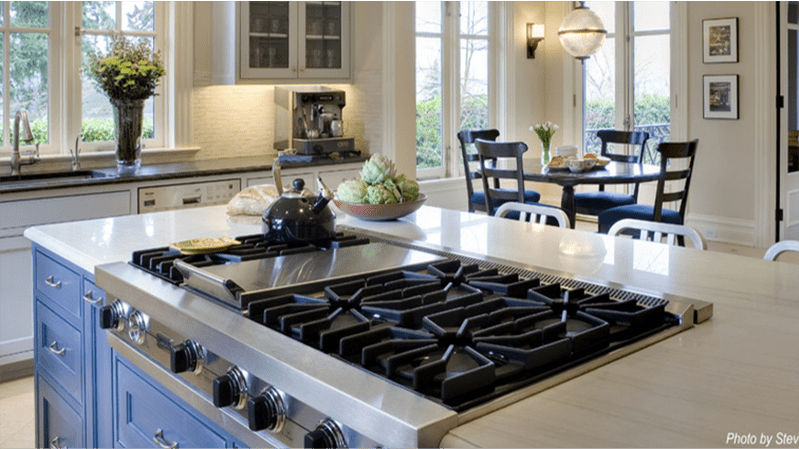
It's not my favorite appliance and won't work when you place it behind a high-output or professional cooktop.
Ever seen a downdraft in a restaurant?
No.
Venting is about capturing smoke, steam, and gasses.
The capture area for the smoke is nonexistent in a downdraft, plus you must reverse gravity.
Downdrafts have no place in new construction but in older retrofits.
So, why are downdrafts specified?
They allow you to not look at a bulkier hood.
You also have the advantages of adding lighting and having a cleaner-looking space.
But the design doesn't work if you cook.
We will show you how to vent later in the article.
Read More: 11 Kitchen Renovation Mistakes to Avoid
Best Luxury Brands and Appliances
The following is a list of the best luxury brands.
- Sub-Zero and Wolf
- La Cornue
- Miele
- Thermador
- BlueStar
- JennAir
- True
- Viking
- Monogram
- Dacor
- Signature Kitchen Suite (SKS)
- Fisher & Paykel
We have an article dedicated to the pros and cons of each luxury brand.
Just know you have plenty of options, and no one brand has every feature, so match the brand to your preferences.
Luxury Appliance Options
- Pro Ranges
- Wall Ovens
- Refrigerators
- Vents
- Dishwashers
- Steam Ovens
- Speed Ovens and Microwave drawers
- Coffee Makers
- Point of Use Refrigeration
- Sinks
We will look more closely at each option, so you know the advantages and drawbacks of each.
Pro Ranges
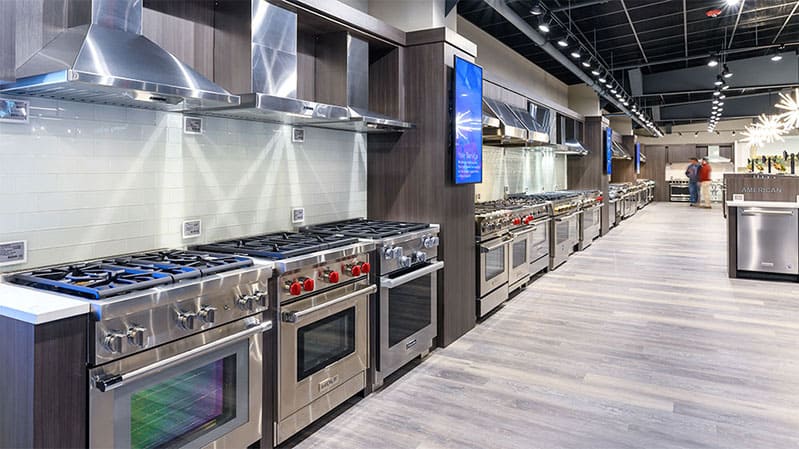
I have said throughout the article there is no one best option for everyone.
I may be wrong about the Chateau Supreme range.
It has a gas and electric range. Gas is better for roasting and broiling, while electric is better for baking. The archtops help maintain an even temperature.
The top can be anything you want, like a Wok burner, grill, griddle, French top, or induction.
So yes, La Cornue may be the best, but at $150,000+, only four were sold globally last year.
To find the right professional range for your lifestyle, you need to ask the following questions:
- Do you bake, roast or broil?
- Do you want more output or a better simmer?
- Would you use a grill, griddle, Sous Vide, or French top?
- Basic controls or Smart functionality?
- Regular oven, steam assist or steam oven?
The best brands to consider for a professional range include Wolf, BlueStar, Miele, and Thermador.
However, SKS has sous vide (precision boiling in a bag) and induction. Fisher & Paykel has its induction and high output gas combination.
Learn More: Pro Cooking Buying Guide
Wall Ovens
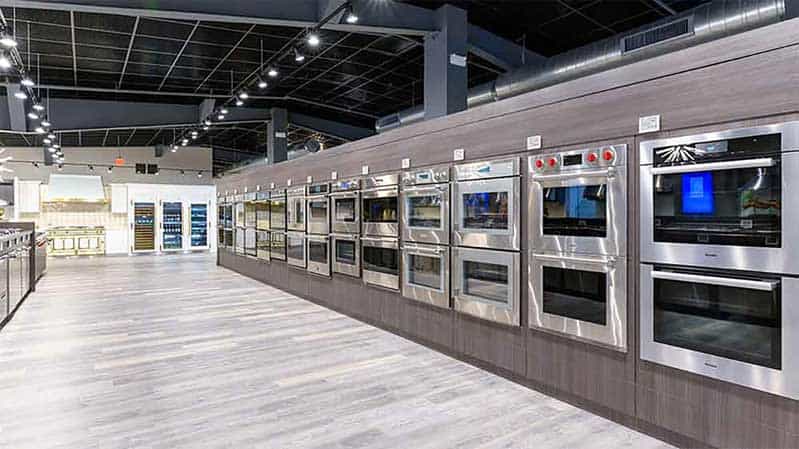
Wolf and Mieleoffere have the most functionality in their wall ovens. Each brand features guided cooking programs.
You just enter food and how you want it cooked, and the ovens calculate time and temperature.
Wolf will show you the best rack position while Miele adds steam assist functionality.
French door ovens allow you to not lift your food over a door and are a cool design element.
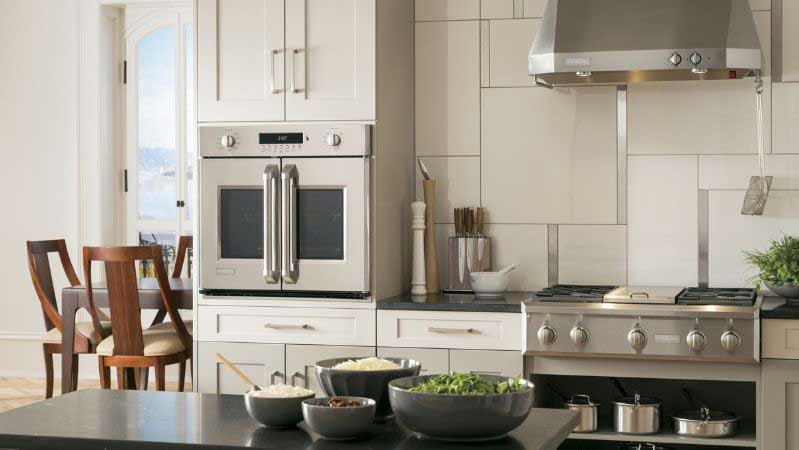
Then you have Gaggenau with 17 different modes and a modern design.
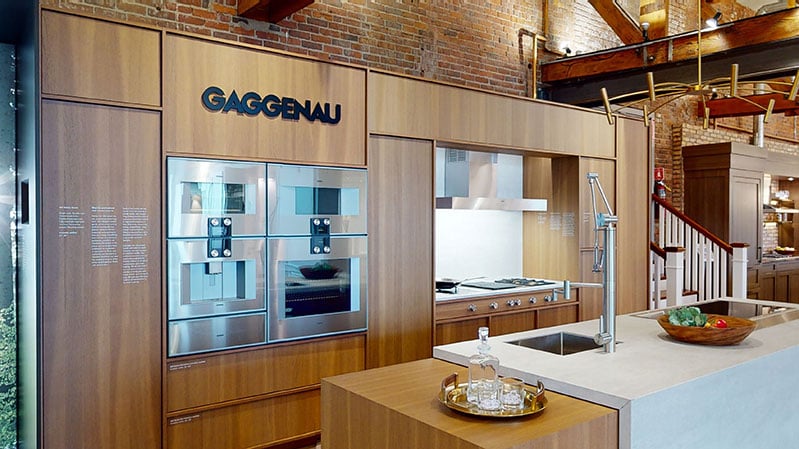
Another consideration is buying a double wall oven or a single with steam, speed, or microwave.
Learn More: Wall Oven Buying Guide
Professional Refrigerators
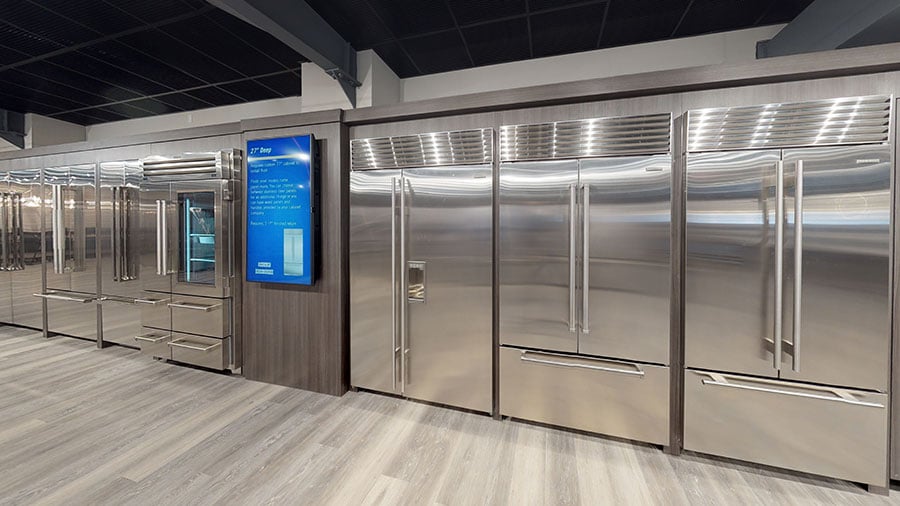
Although you probably consider it important, I haven't spent much time on refrigeration.
For design, it's not crucial that it be placed in the middle of your kitchen, and it is not critical that you access a refrigerator like you stir a pot.
They are also designed to fit standard-size cabinets and are easy to place throughout your kitchen. However, you do have plenty of options.
Professional refrigerators have a compressor on the top to look like a restaurant.
You can buy them in paneled or stained steel. The sizes are 30, 366, 42, and 48 inches wide.
Do you like what you're reading? Subscribe to the Yale Blog and have it delivered right to your inbox. Be the first to know. Over one million people have read and trusted a Yale Guide.
Integrated Refrigerators
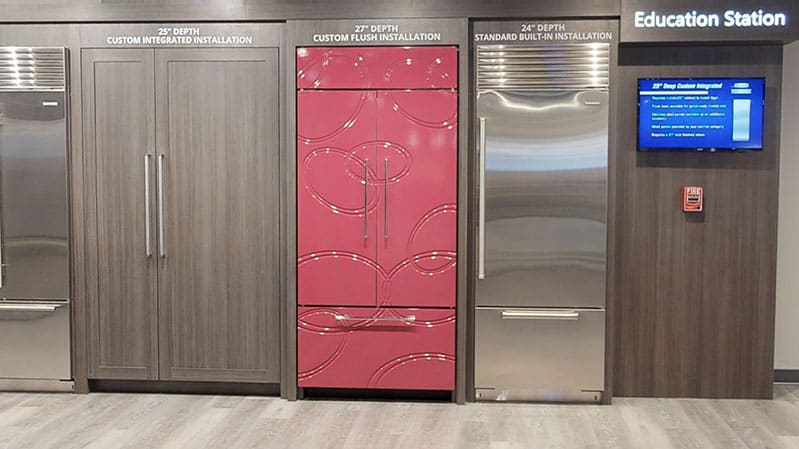
Integrated refrigerators fit within cabinets, so they look like a cabinet rather than a refrigerator.
Integrated has more combinations of refrigerator and freezer, and all refrigerator or freezer types start in smaller sizes like 18, 24, 30, and 36 inches.
Learn More: Refrigerator Buying Guide
Ventilation
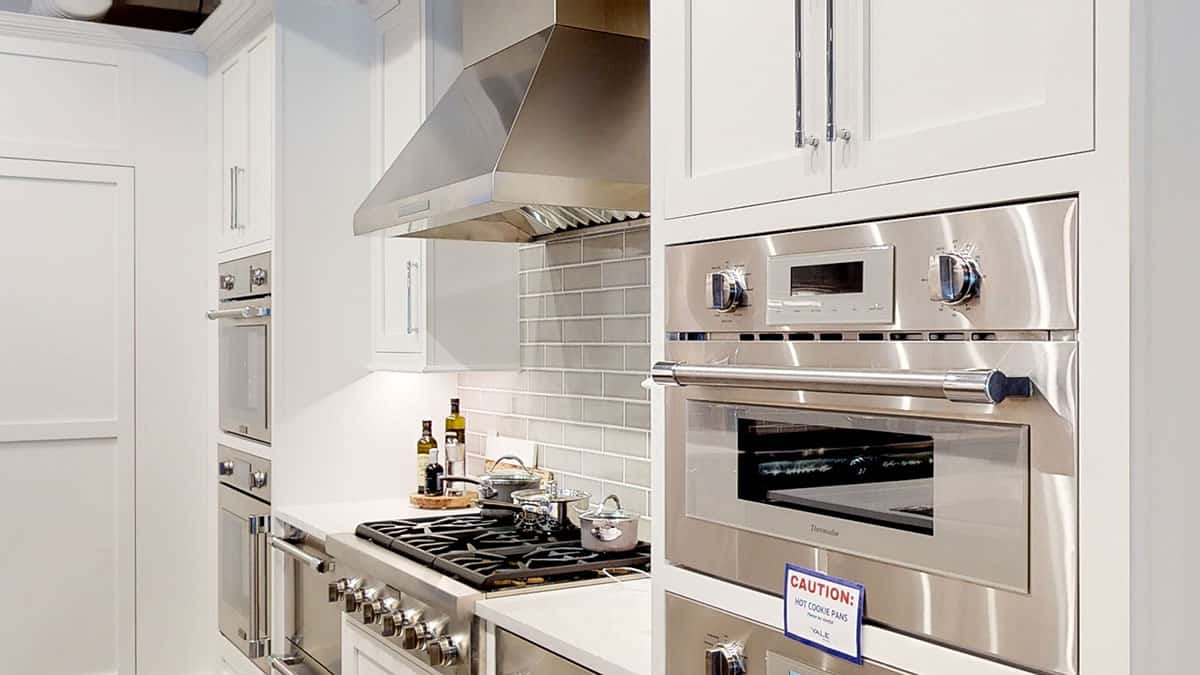
Venting seems easy, but it causes the most problems.
Cooking emits Carbon Dioxide, Carbon Monoxide, particulate matter (PM), Formaldehyde, and Nitrogen Oxide.
Your new windows will keep all those fumes in longer, so you want to vent properly to the outside.
However, you should be aware of the CFM, and the hood's depth is 24 inches to capture the smoke and heat from cooking.
Then, the duct run should be short and straight up or back.
In Massachusetts, you must be concerned with make-up air laws for air returning in hoods over 400 CFM.
Outside of Massachusetts, you should also plan to make up the air.
You can buy your hood in one of two ways: a hood and stainless steel or just a liner and blower to customize in wood or another material.
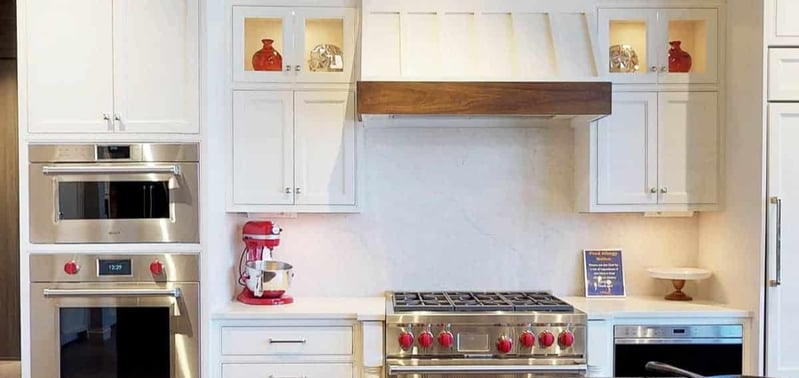
- CFM: Cubic Feet Per Minute or how many cubes of air is exhausted in a minute. 600 over a high output 30 –36 inch range.
- Capture: Depth of the hood. 24 inches depth minimum if over a high output range
- Duct Run: Shorter runs without transitions are the best.
- Duct Size: Larger ducts are best.
- Mass Residents: Make-up air over 400 CFM. If you pull out 600 CFM, you have to put back 600 CFM.
- Take Caution: Downdrafts are last resort only.
Venting is incredibly important. You can download our free Ventilation Buying Guide. It is a short yet incredibly valuable read.
Dishwashers
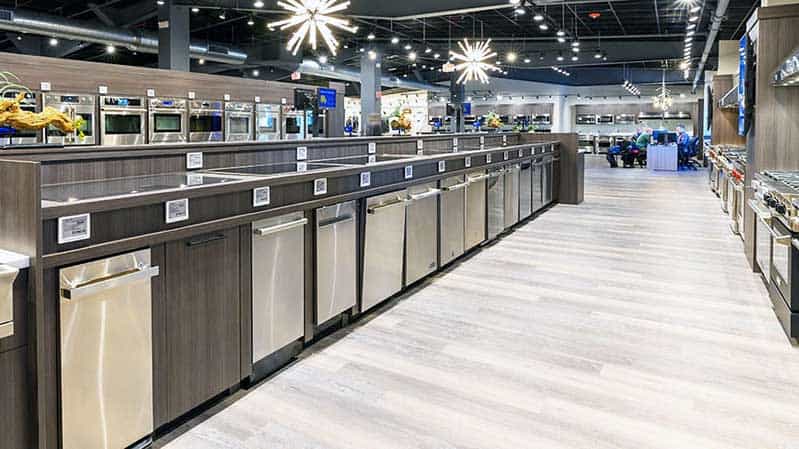
Dishwashers should follow your sink and cooktop as part of your kitchen triangle.
They follow the same dimensions of 24 or 18 inches. Any dishwasher 44 decibels or under will be quiet in an open kitchen.
If you choose to add a custom cabinet panel to the front of your dishwasher, stick with a European brand to mount flush and not protrude past the cabinets.
You have some great options in Bosch, Miele, and KitchenAid, as well as lesser-known brands like SKS, GE Profile, and LG.
Learn More: Dishwasher Buying Guide
Sinks
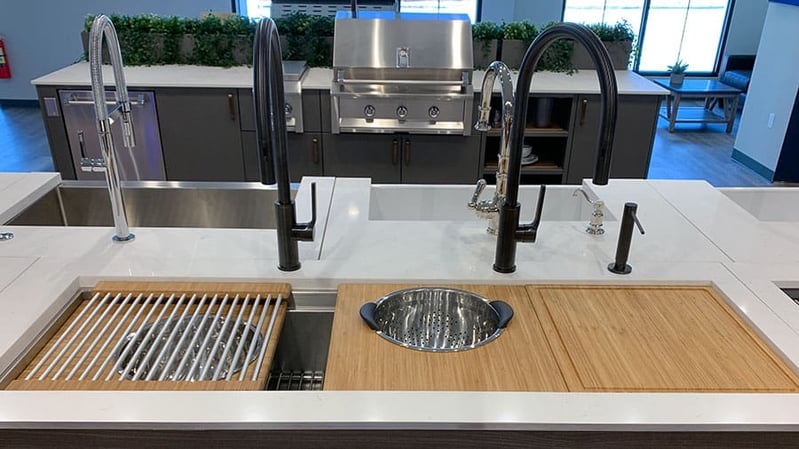
We talked about sinks in my version of the Kitchen Triangle, but sinks can be accessorized to almost anything.
Like the entertaining Galley sink shown above.
Secondary Appliances
If you’re considering any secondary appliances, like steam ovens or coffee makers, think about which ones you’ll use.
Steam Ovens
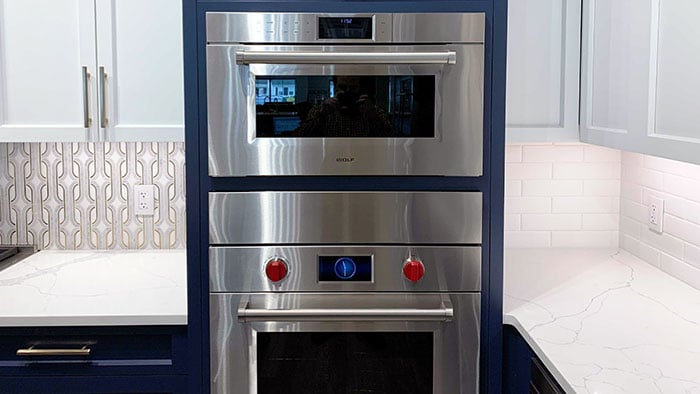
You should consider steam for healthy yet delicious cooking.
Steam adds moisture without baking nutrients. You can cook anything in a steam oven.
It's also great for refreshing leftovers.
Miele is the easiest to use. Gaggenau has the most modes if you know what you are doing.
Note: I love using steam and have vowed to improve my Steam game this year.
Speed Ovens
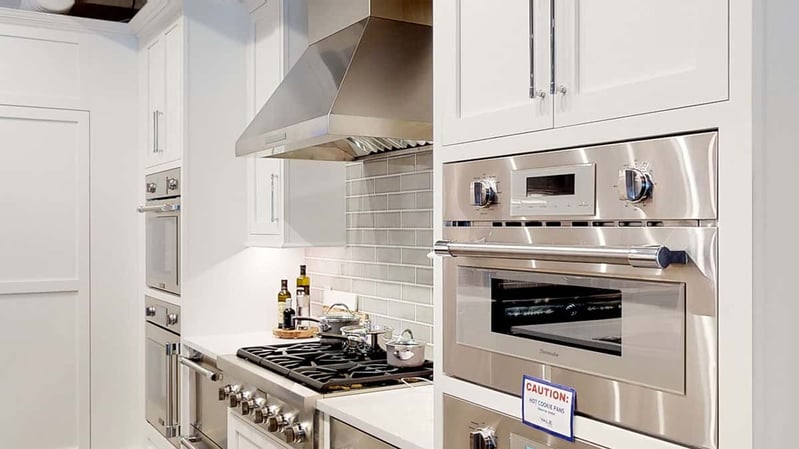
Speed employs convection, microwave, and combination.
The real benefit is the combination of using mostly convection with a microwave assist for speed without the microwaved texture.
Coffee Makers
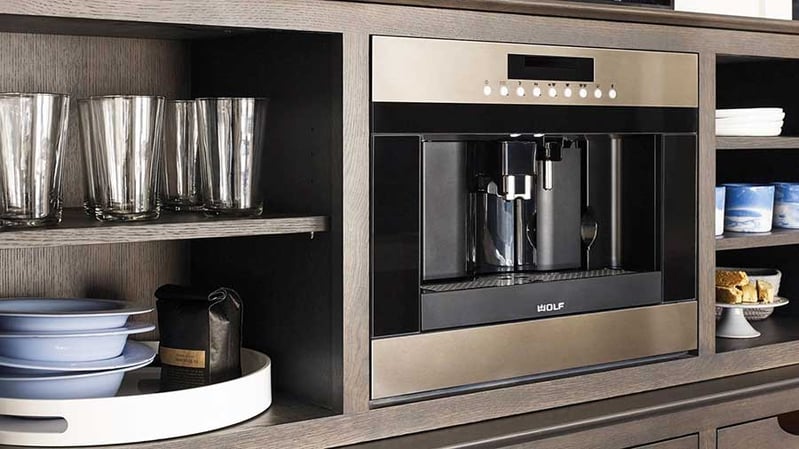
You can have fresh ground coffee at home. My sister brews a blueberry latte to die for.
Miele, Gaggenau, and Wolf are the best for coffee.
Miele, again, is the easiest, while Gaggenau has the most choices.
Warming Drawers
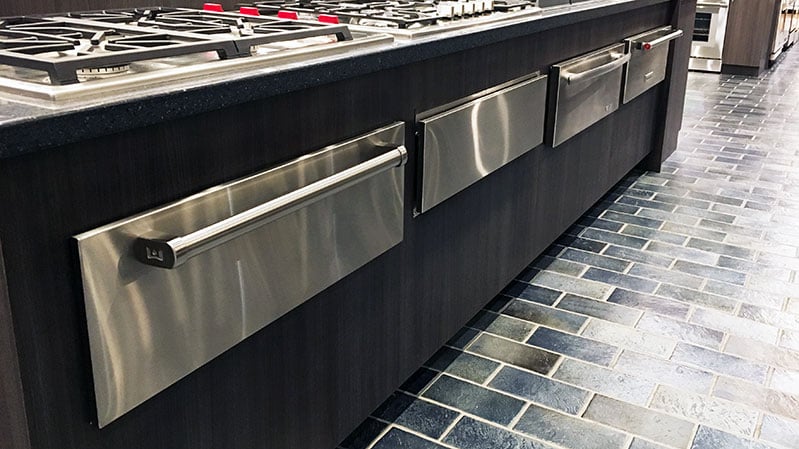
Warming drawers keep food warm for up to three hours without dehydration.
Warming drawers are a good consideration if you cook at one time and your family eats at another. You can also stack a warming drawer under a wall oven or in a standard cabinet.
Point of Use Refrigeration
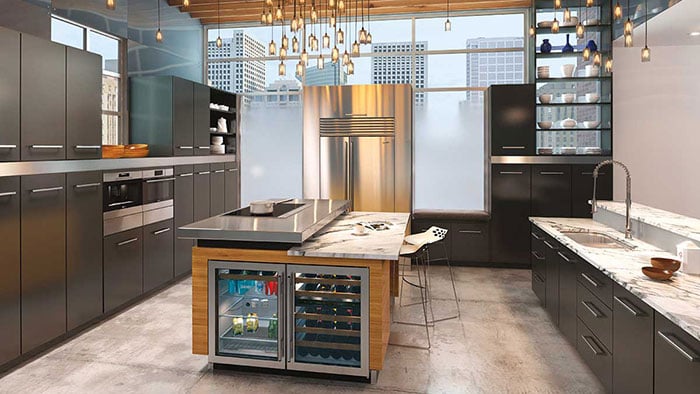
You can now buy any combination of wine, beverage, and refrigeration in a larger or more common under-counter model.
Many people use drawers as secondary refrigerators for their kids. I keep one just for fruit.
Ice Makers
Ice makers are another option. They can produce any style of cubes. The most popular cubes are slushy for soft drinks or clean ice for cocktails.
Look at the Monogram Forge to make the slow-dissolving craft ice, perfect for fine liquor and cocktails.
Pro Tip: You must clean an ice maker twice a year.
Appliance Service
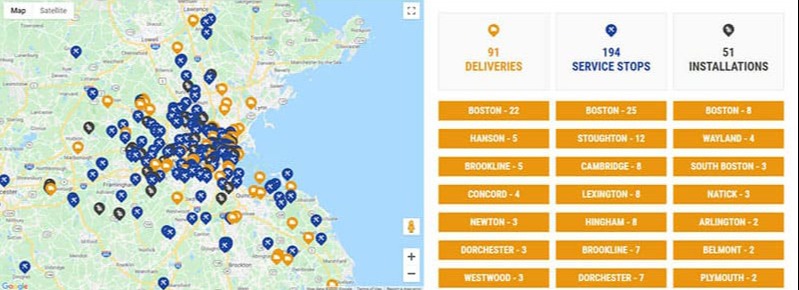
As you can see from this graphic, most of our business is related to service and installation.
Most of what we've seen is highly technical, so make sure adequate repair is available.
With many brands being similar, repair should be a tiebreaker.
Read More: Most Reliable Appliance Brands
How to Design Your Dream Kitchen With Luxury Appliances: Key Takeaways
Hire good people. Good ones are worth the wait.
Understand your lifestyle and how you use your appliances.
No brand dominates. Buy the brand that matches your needs.
Start at your sink, then cook.
Every other appliance falls into place dimensionally; plan your secondary appliances like wine coolers or steam ovens.
Plan your ventilation well.
Repair needs to be addressed before you buy your appliances.
Don't wait to order. Plan 10-12 months out.
Additional Resources
Have questions about appliances? Get the Yale Appliance Buying Guide with features, specs, and detailed profiles of all the major brands. Well over 1 million people have read a Yale Guide.
Related Articles:
- 5 Ways to Make Your Kitchen Unique With Appliances
- How to Choose Appliances for Your Luxury Kitchen
- 6 Timeless Kitchen Design Tips
- Outdated Kitchen Design Mistakes (And How to Fix Them)
- The Most Important Appliance Delivery Checklist
- The Best Luxury Appliance Brands
- The Most Reliable Appliance Brands
Recent Posts
Why Should You Trust Us?
It seems that every appliance review has nothing but glowing comments about almost every product, yet you read customer reviews and they are almost universally bad.
We are here to fill in the disconnect. We'll give you the best features, and the drawbacks as well, including reliability based on over 37,000 calls performed by our service team just last year. Our goal is to give you ALL the information so you know what's right for you.
Please consider subscribing or adding to the conversation in the comments below. We appreciate you stopping by.
Steve Sheinkopf is the third-generation CEO of Yale Appliance and a lifelong Bostonian. He has over 38 years of experience in the appliance industry, and he is a trusted source of information for consumers on how to buy and repair appliances.
Steve has also been featured in numerous publications, including the
New York Times,
Consumer Reports,
The Boston Globe,
Bloomberg Radio, the
New York Post,
The Wall Street Journal, and
Entrepreneur, for his knowledge of how to buy appliances and appliance repair.
Steve is passionate about helping consumers find the best appliances for their needs, and he is always happy to answer questions and provide advice. He is a valuable resource for consumers who are looking for information on appliance buying, repair, and maintenance.
Despite being the worst goalie in history, Steve is a fan of the Bruins and college hockey, loves to read, and is a Peloton biker. The love of his life is his daughter, Sophie.
A Note About Pricing
Pricing on this blog is for reference only and may include time sensitive rebates. We make every attempt to provide accurate pricing at time of publishing. Please call the stores for most accurate price.
